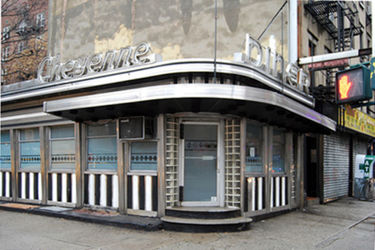Cheyenne Diner: Difference between revisions
No edit summary |
No edit summary |
||
| Line 1: | Line 1: | ||
[[Image:Cheyenne Diner NYC.jpg|right|thumb|375px|The Cheyenne Diner in its original site in New York City. Photographed November 2008 by [http://flickr.com/photos/paul_lowry/ Paul Lowry]]] | [[Image:Cheyenne Diner NYC.jpg|right|thumb|375px|The Cheyenne Diner in its original site in New York City. Photographed November 2008 by [http://flickr.com/photos/paul_lowry/ Paul Lowry]]] | ||
The '''Cheyenne Diner''' (originally the '''Market Diner''') is a classic diner which opened in [[ | The '''Cheyenne Diner''' (originally the '''Market Diner''') is a classic diner which opened in [[1930]] at 411 9th Avenue at 33rd Street in New York City's Chelsea neighborhood. It remained there until [[2009]], when it was moved to [[Birmingham]]. | ||
The 15' x 96' art moderne stainless-steel and glass building is of the "railroad car" type design produced by Paramount Modular Concepts of Oakland, New Jersey. The exterior of the building is stainless steel with inset enameled panels below the windows and a neon sign on the cornice. The door and a bank of pay phones is sheltered under a curving roof extension at the corner. The door is flanked by glass block pillars. Interior walls and counters are faced with burgundy and white ceramic tile, with burgundy enamel mullions between the windows. | The present 15' x 96' art moderne stainless-steel and glass building dates to [[1940]] and is of the "railroad car" type design produced by Paramount Modular Concepts of Oakland, New Jersey. The exterior of the building is stainless steel with inset enameled panels below the windows and a neon sign on the cornice. The door and a bank of pay phones is sheltered under a curving roof extension at the corner. The door is flanked by glass block pillars. Interior walls and counters are faced with burgundy and white ceramic tile, with burgundy enamel mullions between the windows. | ||
Its name was changed to Cheyenne in [[1986]]. At that time the menu was updated to include "bison burgers" and "mohegan burgers" with bacon, cheese, barbecue sauce and fried onions. The interior decor also adopted a western theme, with photographs of Native Americans alongside the promotional glossies from celebrities. At the time it closed the curved ceiling was illuminated with sconces and the booths were upholstered in red and gray vinyl with stained wood trim. ''New York Architecture'' listed the Cheyenne as the best diner in New York [http://www.nyc-architecture.com/TEN/TEN-diners.htm]. | Its name was changed to Cheyenne in [[1986]]. At that time the menu was updated to include "bison burgers" and "mohegan burgers" with bacon, cheese, barbecue sauce and fried onions. The interior decor also adopted a western theme, with photographs of Native Americans alongside the promotional glossies from celebrities. At the time it closed the curved ceiling was illuminated with sconces and the booths were upholstered in red and gray vinyl with stained wood trim. ''New York Architecture'' listed the Cheyenne as the best diner in New York [http://www.nyc-architecture.com/TEN/TEN-diners.htm]. | ||
Revision as of 19:30, 15 January 2009

The Cheyenne Diner (originally the Market Diner) is a classic diner which opened in 1930 at 411 9th Avenue at 33rd Street in New York City's Chelsea neighborhood. It remained there until 2009, when it was moved to Birmingham.
The present 15' x 96' art moderne stainless-steel and glass building dates to 1940 and is of the "railroad car" type design produced by Paramount Modular Concepts of Oakland, New Jersey. The exterior of the building is stainless steel with inset enameled panels below the windows and a neon sign on the cornice. The door and a bank of pay phones is sheltered under a curving roof extension at the corner. The door is flanked by glass block pillars. Interior walls and counters are faced with burgundy and white ceramic tile, with burgundy enamel mullions between the windows.
Its name was changed to Cheyenne in 1986. At that time the menu was updated to include "bison burgers" and "mohegan burgers" with bacon, cheese, barbecue sauce and fried onions. The interior decor also adopted a western theme, with photographs of Native Americans alongside the promotional glossies from celebrities. At the time it closed the curved ceiling was illuminated with sconces and the booths were upholstered in red and gray vinyl with stained wood trim. New York Architecture listed the Cheyenne as the best diner in New York [1].
On April 6, 2008 the Cheyenne closed for good and property owner George Papas made plans for a 9-story condominium tower on the site. A proposal to move the diner to Red Hook, Brooklyn proved unworkable because no bridge connection from Manhattan to Brooklyn would allow the diner's sections to make the trip. In the summer of 2008 the diner was used as a filming location for a Quentin Crisp bio-pic entitled An Englishman in New York.
In January 2009 a deal with Birmingham's Joel Owens was completed, opening the way for the diner to be relocated to Birmingham to become part of a "classic car museum" and special events center.
References
- Walsh, Kevin (April 2008) "Last Roundup: Cheyenne Diner gives way" Forgotten NY: Street Scenes
- Shott, Chris (April 22, 2008) "Diner-Man to the Rescue! Mild-mannered Michael Perlman moonlights as dashing diner hero" New York Observer
- Hedlund, Patrick (January 2, 2009) "Cheyenne Diner looks ’Bama-bound" Chelsea Now. Vol. 3, No. 13
- "Historic Cheyenne Diner to Retire South in its Golden Years: New Lease on Life in Birmingham, AL." (January 14, 2009) Press Release. Committee to Save the Cheyenne Diner.
External links
- Photos of the Cheyenne on Flickr.com